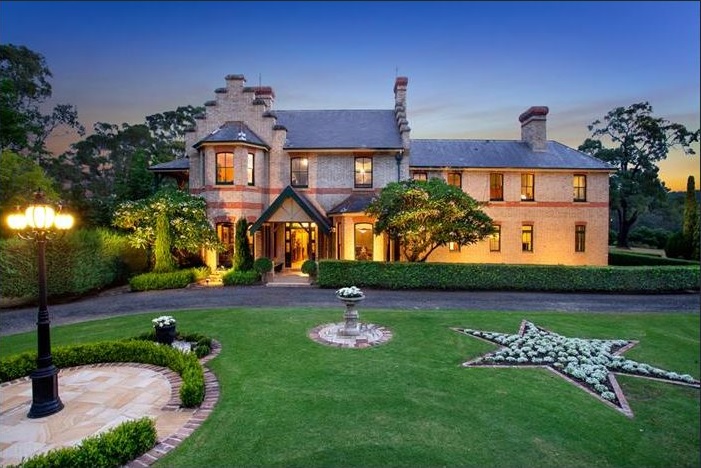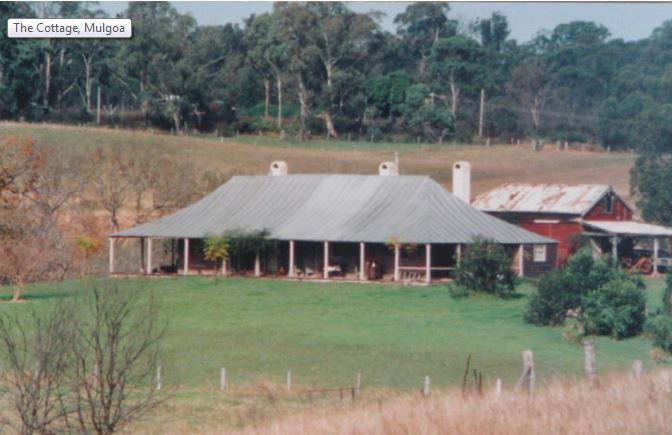Penrith City Local History - Places - Suburb profiles - Mulgoa
Mulgoa
Mulgoa is located south of the suburbs of Regentville and Glenmore Park within the City of Penrith. The Nepean River runs along its western boundary with the village of Wallacia located to its south. The suburbs of Kemps Creek and Orchard Hills run along its eastern border. Mulgoa today has gone full circle, from the early farming, vineyards and orchards, to the guest houses of the first part of the twentieth century, it is now an area of extensive hobby and general farming, with some tourist through traffic. The twin villages of Mulgoa and Wallacia add value to the City of Penrith because they retain strong connections with the early pioneers who initially settled the area.
Mulgoa on Google Maps.
The Cottage built by William for his sons and their tutor in 1811, and later used by his sons before their own homes were built, still stands, and is one of the oldest homes remaining in the Penrith area. The Mulgoa Valley became, for a period, the architectural showpiece of the Colony, with the homes of the numerous members of the Cox family, the Nortons and others being consistently of a grand nature.
Glenleigh
Glenleigh was built as a country residence for shipping merchant, businessman and philanthropist, James Ewan and his wife, between 1887 and 1889. Glenleigh’s distinctive appearance stems from the unusual bricks which were shipped across from England as the ballast in James Ewan’s merchant ships. Timber verandahs and an imposing timber entry porch add to the fine exterior. The site occupies a prominent position overlooking the Nepean Valley.
 Photo by Real Commercial Estate Agents
Photo by Real Commercial Estate Agents

Photo by Real Commercial Estate Agents
Glenmore
The Georgian section of Glenmore was built by Henry & Frances Cox in 1825. The property produced wheat crops and orchards, however by 1851, due financial difficulties, Henry was forced to sell Glenmore to Thomas Sutcliffe Mort. Thomas Mort did not own the property for very long and in 1854 it was sold to James Riley who refurbished the home and added the southern wing. In 1904 Glenmore became a select school for young ladies. In 1927 a Sydney syndicate formed the Glenmore Country Club.
Fernhill
Fernhill was built by Edward Cox in 1814 and remained in the Cox family until it was sold in 1885. It appears to have been originally designed as a two storey building however it was completed as a single storey building because of the 1840’s recession. It is picturesquely sited, overlooking the surrounding countryside.

Photo by Christie’s International Real Estate

Photo by Christie’s International Real Estate
The Cottage
The Cottage was begun around 1810 by William Cox, who would, in 1814, build the first road across the Blue mountains. The Cottage is built on land granted to William’s four and half year old son Edward in 1809 by Lieut-Governor Colonel Paterson. Governor Macquarie re-granted the same land back to Edward in 1810. Reaching its full completion in 1820, is one of the earliest timber-framed structures still surviving in Australia.


St Marys Catholic Church
The church was built around 1890 as part of the speculative boom associated with the Mulgoa Irrigation Company Scheme. The church has parapeted gables and a corrugated iron roof.

St Thomas’ Church: The land for this Gothic Revival, rural Anglican church was donated by Edward Cox in the 1830s. It was designed by James Chadley and Thomas Makinson, and built by Robert Drysdale. The foundation stone was laid in 1836 with the church being consecrated in 1838. A parsonage built nearby was demolished in the mid 1960s.

Winbourne
Winbourne was granted to George Cox in the early 1800s who built Winbourne and established a large estate, which included orchards, vineyards, wheat fields and dairying. The family remained on the property until 1901. In 1914 Tom Campbell leased the property and ran it as a holiday resort until 1958 when the site was purchased by the Christian Brothers. The main house was destroyed by fire in August 1920.

| 1810 | First land grant in district. 300 acres to Edward Cox | |
| 1811 | The Cottage built by William Cox for his sons and their tutor | |
| 1825 | Henry Cox built Glenmore on land which was once Luttrell land grant | |
| 1836 | 22 August | Foundation stone laid for St Thomas Anglican Church |
| 1868 | 29 March | Rev. Thomas Hassall, first minister at St Thomas' Mulgoa died |
| 1852 | James J Riley Penrith's first mayor (1871) purchased Glenmore | |
| 1893 | 26 July | Mulgoa proclaimed a municipality |
| 1927 | Glenmore Country Club established with 18 hole | |
| 1949 | 1 January | Mulgoa Municipality joined with Castlereagh, St. Marys, and Penrith Municipalities to form one large Municipality of Penrith |
| 1984 | Local Environmental Study of Mulgoa and Wallacia (Penrith City Council) | |
| 1993 | Nepean District Christian School opened on Mulgoa Road | |
| 1999 | June | Release of the Mulgoa & Wallacia Study and Strategy by Penrith City Council |
